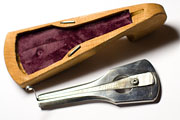I.N.Gotovtcev's Khomus
Archived model (?)
|
The khomus of the Yakut master Innokenty Nikitich Gotovtsev is a jew's harp with a bright and effective sound. Many very different sounds are born at the first hint; with intense blows and breathing, the instrument begins to produce an amazing range of cosmic overtones. Loudness also spreads over a wide range, along with a "shrill" frequency range, so you don't have to worry about your music being lost in an environment other than home. The danger of getting lost - in the abundance of sounds simultaneously emitted by the instruments - lies in wait for the performer himself. The reason for this is the very low purity of the timbre - everything that can sound has been mixed in a bunch, creating the very wi-effect ...
The monolithic massive frame of an unconventional form for the Yakut khomuses allows you to hold the instrument without tension either with your fingers or with a grip "away from you." The special shape of the hollowed out decks leads to increased air consumption when playing with active breathing. The jew's harp has a tendency to lose control when hitting an already vibrating tongue, in which strong parasitic vibrations often occur, turning the sound into mush. At low speeds and in the simplest fight, Gotovtsev's khomus can be successfully used even by a person who has not played harps before.
The monolithic massive frame of an unconventional form for the Yakut khomuses allows you to hold the instrument without tension either with your fingers or with a grip "away from you." The special shape of the hollowed out decks leads to increased air consumption when playing with active breathing. The jew's harp has a tendency to lose control when hitting an already vibrating tongue, in which strong parasitic vibrations often occur, turning the sound into mush. At low speeds and in the simplest fight, Gotovtsev's khomus can be successfully used even by a person who has not played harps before.










